
The players live on this well-known island in the middle of the Pacific Ocean.
The main island is well-populated and everyone follows his own business.
Fishermen fish, surfers surf, dancers dance, and the fruits grow…
Also the surrounding islands look very beautiful from the main island
and offer many interesting places to visit.
As chieftains, the players have been granted land by the island’s king. Now they must
prove their value by making their own realms prosper. They build huts and temples, plant
fruits, catch fish, support the arts of dancers and surfers, seek out kahunas and acquire
tikis. The player who finds the best combinations will be declared the most valuable
chieftain and win the game.
The following rule changes apply here on yucata.de:
- In the online version, all fruits, shells and feet of each player are visible for everyone.
 Hawaii:
Rules by Rio Grand Games
Hawaii:
Rules by Rio Grand Games
Game Setup
1. The players assemble the 6 puzzle sections to create the
board frame. Then shuffle the 10 large rectangular places face-down and put them face-up
within the frame, beginning on the lower left, moving to the right and then doing the same for each
row above, in order, aligning all with the beach. See figure to the right for a possible configuration.
2. Now put the 126 place tiles on the places. Most place tiles have different front and rear sides. The
fronts have a I in the upper left corners, the rear sides have a II in the upper left corners.
Stack the place tiles face-up (side I) on the places matching the illustrations on the place tiles.
3. Each player selects a color and takes a player board, 1 fishing boat, the chieftain, and 2 sub-chiefs in his color.
The player places the player board and fishing boat in the area near him. He puts the chieftain on the beach.
He puts one sub-chief on the player sequence track, and the other on the scoring track.
4. Shuffle the islands, then draw 4 islands and put them face up next to the 4 docks.
Put the other islands as a face-down stack near the beach (Yucata does not show the stack).
The players sort the round indicators by the value shown on the turtle shell and stack them face up on the space provided on the
beach, in order, with the 17 on the bottom and the 9 on top.
|
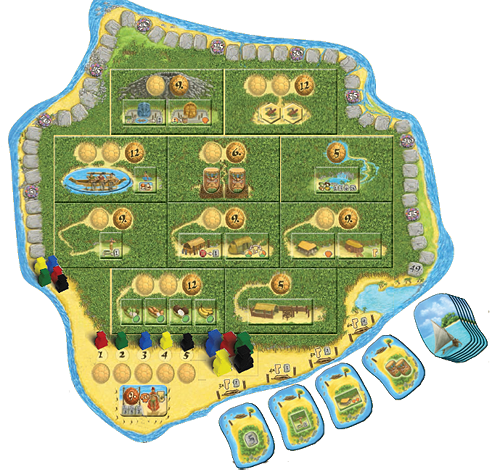
|
 |
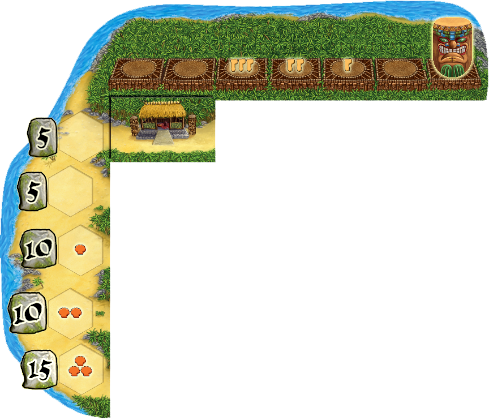 |
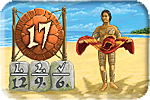 |
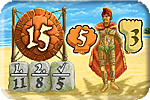 |
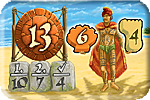 |
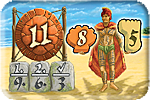 |
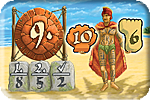 |
| Round 5 |
Round 4 |
Round 3 |
Round 2 |
Round 1 |
5. Each player gets 13  and 7
and 7  .
.
In addition, distribute 2 green fruits to the player whose sub-chief is on space 2 of the player order track, 3 fruits to the player
on space 3, 4 fruits to the player on space 4, and 5 fruits to the player on
space 5. The player on space 1 gets no fruits!
2nd player: 

3rd player: 


4th player: 



5th player: 




Note:
The players normally put and keep their resources behind their screens. On Yucata.de, it is a common practice that you can see the resources of your opponents.
Lay out the price tokens
These determine how much the place tiles cost.
- Beginning at the lower left of the board, the banker puts price tokens on each empty circle on the 10 places.
- Each place has 1, 2, or 3 purchase circles on which the banker puts the price tokens. One circle in each place is
pre-printed with a number between 5 and 12. In addition, each place has 0-2 un-printed circles.

The banker does the following, for each place:
- The banker draws 1 price token from the bag for each un-printed purchase circle and puts this with the
numbered side up on the un-printed purchase circles. When putting the tokens on the un-printed circles, the
banker takes no special note of the different colored tokens (orange/red with spears). Places with only one
purchase circle do not have un-printed purchase circles and, thus, the banker will put no tokens there.
- Next, he draws 1 additional price token from the bag for the pre-printed purchase circle.
Next, he adds the numbers on all the price tokens he has drawn for this place.
- If the total of the price tokens is equal to or lower than the number on the pre-printed purchase
circle, then he puts the drawn price token on it.
- If the sum of the price tokens is higher than the pre-printed number, he puts the drawn price token, with the
fish side up, on the cove. The pre-printed purchase circle remains uncovered in this round.
Hint:
On Yucata.de, all free purchase circles will be shown without the pre-printed numbers. So it easier to see, that these purchase
circles cannot be used in this round.
- Even if the number on the pre-printed purchase circle is equal to the price token(s) the banker put on the unprinted
circle(s), he still draws a price token and places it fish side up on the cove.
- After all places have been filled with tokens in this way, the player draws more price tokens from
the bag: 1 fewer than the number of players in the game. He puts the price token with the lowest
number on the circle under the 2 on the beach. He puts the next higher price token on the circle under
the 3, and so on. If 2 tokens have the same number, the one (if any) with the spear is considered higher.
Thus, there is a price token under each sub-chief, except on the 1.
Now the preparation is complete and the game can begin.
Overview
The players develop their realms in the course of the game. They establish up to 5 villages, build boats in
order to trade, train kahunas, and honor the Gods. Although the players score points during the game, the
winner is not known until the final scoring.
The game is played over 5 rounds. Each round consists of the following 2 phases:
I. The turn of the chieftains
II. End of the round
After the 5th round, the final scoring occurs and the winner is determined!
I. The turn of the chieftains
The players move their chieftains from place to place in order to buy place tiles. They can also move their
chieftains to the beach in order to fish, to visit islands, or end their turns.
The player whose sub-chief is on space 1 of the player sequence track, begins. The other players follow in
order based on their positions on the player sequence tracks: 2, 3, and so on.
Note: thus, Hawaii is not played in clockwise order!
When all players have moved their chieftains once, the players move them again
beginning with the player whose sub-chief is on space 1 of the player sequence track.
This continues until no player can or wants to move his chieftain. Then the phase of
the chieftains ends and the round end phase begins.
How do players move their chieftains?
The player can move his chieftain from the beach to a place, from a place to another place, from a place to
the beach, or not move his chieftain, leaving him where he is. When moving their chieftains, the players
follow these rules:
- The chieftains begin each round on the beach. Only the two lower places are neighboring to the beach.
- 1 step from the beach to a neighboring place costs 1 foot.
- 1 step from a place to a neighboring place also costs 1 foot. The chieftain can cross several places in his
move before stopping. Each step (from place to place) also costs 1 foot. If the chieftain does not move, but
remains where he is, that also costs 1 foot.
- If the chieftain moves from any place to the beach, that does not cost
anything! Likewise, it costs nothing to move the chieftain from one
space on the beach to a different space on the beach or for him to leave
his chieftain on the same space on the beach.
| Example: |
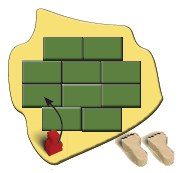 |
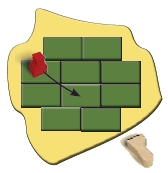 |
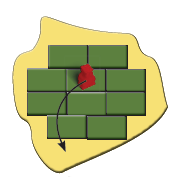 |
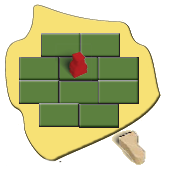 |
| 2 steps cost 2 feet |
diagonal moves are allowed |
the move back to the beach
costs nothing |
remaining in a place costs 1 foot |
The places a player may move his chieftain
- On any of the 10 places with 1 or more place tiles and 1-3 price tokens at the start of the round.
Note: it is possible for places with 1 purchase circle to have no price tokens at the start of the round.
- A player can move his chieftain only to a place which has at least 1 place tile and at least 1 price token. If
both are not on a place, the player may not move his chieftain there, but may move across the place.
- A player can leave his chieftain on a place where he already stands only if there is at least 1 price token still
there.
- When a player moves his chieftain to a place (or leaves it in a place where it was), he must buy a place tile
from that place.
- A chieftain of another player does not prevent a chieftain from crossing a place or moving to a place as long
as there is at least 1 price token in the place the chieftain stops.
The purchase of place tiles
- A player who moves his chieftain to a place must choose one of the place tiles there to buy. If only 1 type is
there, he must buy this one. If there are 2 types there, he can choose freely from those 2. He may buy only 1
place tile per turn.
- Then he must pay for the chosen tile. To do so, he selects one of the price tokens in that place and puts it
face-up in his play area. He next pays the amount shown on the selected price token in shells by moving the
shown number of shells from his play area to the general supply. The price token remains in his play area
and will play a further role at the end of the round.
- Finally, he takes the tile he has chosen and puts it in his play area.
- The player can choose to pay either the amount shown on the price token or double that amount. If he pays
the amount shown, he puts the place tile in his realm with side I showing. If he pays the double amount,
he puts the place tile in his realm with side II showing. As the kahuna and tikis have no side I or II, if the
player pays the amount shown, he takes and puts 1 tile; if he pays double, he takes and puts 2 tiles.
- The player places the price token in his play area face-up whether he pays the amount shown or double.
Other rules for buying and putting place tiles
- The player must be able to immediately and legally put the chosen place tile into his realm. If he cannot do
that, he cannot choose to buy it. The rules are given in the descriptions in the supplement.
- Once a player has put a place tile in his realm, he may not later move it or turn it over to its other side (e.g.
from side I to side II).
- Each row represents a village. During the final scoring, only villages that are long enough to reach the
player’s row of tikis will score points for the player.
The beach and what a chieftain can do there
The beach has 3 spaces, which the chieftain can visit (one in each turn):
1. The fishing cove, where the chieftain can fish.
2. The docks, from which the chieftain can visit the 4 islands.
3. The player sequence track (5 spaces) and the round indicators.
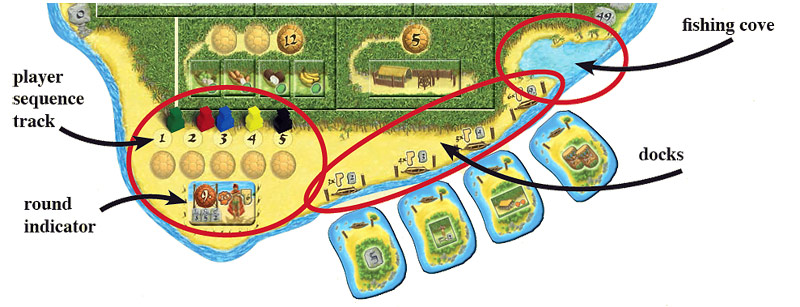
Note: For everything that a chieftain does at the fishing cove or at the docks,
the player must pay with feet  instead of shells.
instead of shells.
In general:
The place tiles are paid with shells.
The chieftain movement is paid with feet.
Fish and island visits are paid with feet.
The use of fruits is explained later.
1. The fishing cove
- If the player wants to fish, he moves his chieftain to the fishing cove and takes 1 or more of the fish tokens
that are there (remember, these have the numbers face-down). He puts the fish tokens with the fish side up in
his play area. Like the price tokens, the fish tokens play a role at the end of the round.
- For each fish token the player takes, he pays 1 foot, regardless of the quantity of fish or the number on the
underside of the token. Also, the player must use one of his unused boat spaces for each token he takes.
Afterwards he turns the used boat(s) as shown below to indicate they cannot be used again this round.
2. The docks for the 4 islands (island visit)
- If the player wants to visit an island, he moves his chieftain to the island dock of his choice. Then, the
player immediately moves his sub-chief on the scoring track to record the points indicated.
- Then the player takes what is shown on the island (place tiles or points).
- Next, the player must pay for the island visit with feet. The cost (in feet) is shown on the chosen dock.
Additionally, he needs 1 or more boats to accommodate the feet shown. If a player has too few feet or not
enough space on his available boats, he cannot move his chieftain to this dock!
- The player returns the visited island face-up under the island stack.
- If the player cannot put the place tile that is shown into his realm, or if there are no more place tiles of the
kind shown available, he scores only the points on the dock for the island visit.
3. The player sequence track and the round indicators
- When a player cannot or chooses not to buy anything else, he places his chieftain under the player sequence
track on the empty space (no other chieftain) of his choice. He takes the price token there (except with
space 1, where there is none) and puts it in his play area with any others he collected this round. Thus, he
ends his participation in the round and can no longer move or use his chieftain this round. All other players
who have not yet placed their chieftains under the player sequence track continue to take their turns as they
have during the round. When all the chieftains are there, the phase of the chieftains of this round ends.
- The round indicator remains in place, as it is needed for the second phase of the round.
II. End of the round
At the end of each round players score points, recording them by moving their sub-chiefs on the scoring
track. Then, all players take new shells, feet, and fruits.
- For the end of the round scoring, each player adds the numbers on all his price and fish tokens. All players
compare their sums with the large number (required to keep people in the player’s realm happy) on the
round indicator. If a player’s sum is smaller than the large number, the player does not score any points. If
the player’s sum is equal to or larger than the large number, the player scores points as described below.
- The player with the highest sum scores the points shown on the round indicator under the 1. The player
with the second highest sum scores the points under the 2. All players who do not have the highest or
second highest sum, but have a sum at least as high as the large number, score the points shown under the 3.
If several players tie for the highest sum, each scores the points shown under the 1. All other players
whose sum is at least as high as the large number, score the points shown under the 3. If there is just one
player with the highest sum (he scores the points under the 1) and several with the second highest sum,
those with the second highest sums all score the number under the 2.
| Examples of the points scored at the end of the 1st round: |
 |
Red, Green and Blue had sums of their price
and fish tokens equal to or greater than
the large number (9).
These players score points as show below:
Red has the highest sum with 14 and scores
8 points as the first player.
Green is second with 11 and scores 5 points.
Blue scores 2 points.
Yellow has a sum less than 9 and scores
no points. |
|
All players had sums of their price and fish tokens
equal to or greater than the large number (9).
All players score points as show below:
Red and Green tie for the most with sums of 11 and each scores 8 points.
Because there was a tie for first, the second player
points are bypassed, so no player scores 5 points.
Blue and Yellow each score 2 points for having sums equal to or greater than 9,
but not finishing first or second. It matters not that Blue has a higher
sum than Yellow.
|
- After the scoring, the supply manager distributes new shells, feet, and fruits to the players.
How many each player gets is shown on the round indicator.
The round indicator depicts a man carrying a shell and a foot, each with a number. That is how many shells
and feet the supply manager gives to each player. In addition, he gives players extra shells and/or feet when
they have special place tiles that award them extras at the end of the round.
The supply manager gives fruits to players who have place tiles that award them fruits at the end of the
round, giving them the number shown on those tiles. Players without such place tiles will receive no fruits
at the end of the round.
- Afterwards, the supply manager puts the top-most round indicator back into the box.
- The banker arranges the sub-chiefs above the player sequence track exactly according to the order of the
chieftains who are under it. They indicate the player sequence for the next round. Then each player places
his chieftain back on the beach.
- The banker puts all price and fish tokens back into the bag. Then he puts them out again in the same manner
as described at the beginning.
- Players move any islands remaining next to the docks to the left and draw new islands from the stack to
fill any empty spaces. If no islands were visited in the previous round, the current set of islands remains in
place. As before, if face-up islands appear, shuffle the islands in the stack and place them face-down as a new stack.
The next round begins with the turn of the chieftains. The player whose sub-chief is on space 1 of the player
sequence track begins and the others follow in player sequence order.
At the end the fifth round, players execute the scoring, skip the preparation for the next round and move
directly to the final scoring.
The final scoring (after the 5th round):
At the end of the 5th round, the player who places his chieftain in the first position on the player-sequence
track is awarded a bonus of 2 VP when calculating the end-of-round scoring.
The following place tiles are scored:
the kahunas, the Gods KANALOA and LAKA, the irrigation systems, the hula dancers, and the long huts side II.
A kahuna, an irrigation system, a hula dancer and a long hut side II only score points in the villages in which they are located.
The two Gods score points regardless of which
village they are in. For a village and the place tiles or kahuna in a village to score, the village must be long
enough to reach at least one tiki that the player has put along the top of his realm. Otherwise the player
removes the entire village from the final scoring! After all players have scored their villages, the player with
the highest score wins. If players tie with the highest score, the player among them with the highest total of
remaining shells, feet, and fruits wins. If there is still a tie, the tied players rejoice in their shared victory.
Example 1:
Before the final scoring: the foot hut in the 4th village is removed, because the village
does not reach at least 1 tiki. The 10 kahuna points expire. Also, the 1st village is removed
from the final scoring, at which point the 5 kahuna points expire.
For the final scoring: the kahunas on the 2nd and 3rd villages, the Gods LAKA and KANALOA, the
hula dancer and the irrigation system score. The player scores the following points:
Kahunas for the 2nd and 3rd villages: 15 points
KANALOA I: scores 2 points for each boat and for each surfer for a total of 8 points.
LAKA II: scores 2 points for each fruit on the fruit tiles (not for the wooden fruits!) for a total of 8 points.
|
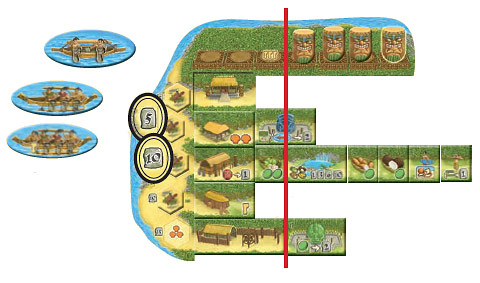 |
Hula-Tänzerin I: 7 space tiles in her village for 7 points.
Irrigation system: there are 3 fruit tiles in the village for a total of 6 points.
Thus, the player has a total of 44 points, which he records on the scoring track.
|
Example 2:
Before the final scoring, the 3rd village is removed as it does not reach at least 1 tiki. Thus the 10
kahuna points and KANALOA are not scored in the final scoring.
Kahunas for the 1st and 2nd villages: 10 points.
LAKA I: for 4 fruit tiles it scores 4 points.
Hula dancer II in 1st village: 10 points.
Hula dancer I in 2nd village: 8 points.
Irrigation system in 2nd village: 10 points.
The player scores a total of 42 points, which he records on the scoring track.
|
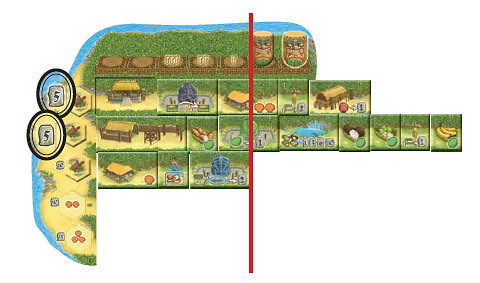 |
The place tiles: where to put them and what they bring.
- Put all rectangular place tiles within the angle of the realm.
- Put fishing boats to the left of the realm.
- Put kahunas on the realm, beginning on the top to the bottom without gaps.
- Put tikis on the realm, beginning at the right side to the left side without gaps.
A row of place tiles is called a village. A player can build up to 5 villages.
 
 

|
A player may only start a new village with one of
these 5 place
tiles (all picture a hut of some kind).
A player can also add them
to an existing village. |
A player must begin building villages at the top of his realm and work his
way downward without gaps. A village need not be completed to start a new one.
A player may never put a second place tile of the same kind in a village, even if it is the opposite side (side
I vs side II). However, a player may put 4 different fruit tiles in a village.
Note:
On Yucata.de, fishing boats will be shown next to the player info.
There is not enough space to show all ships of your opponents. If a opponent owns more than 3 boats,
you can see only the unused boats. If he owns more than 3 unused boats, you will see the biggest ones.
What the place tiles offer the players and when
Shell huts (round end)
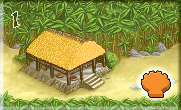
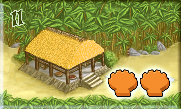
Side I: the player receives 1 extra shell when the supply manager distributes the shells at the end of the round. Side II: 2 extra shells instead.
1 extra shell (foot) means that the player gets an extra shell (foot) during resource distribution (in addition to
the basic amount). All such shells and feet are added to the basic distribution.
Feet huts (round end)
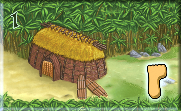
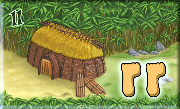
Side I: the player receives 1 extra foot when the supply manager distributes the feet at the end of the round. Side II: 2 extra feet instead.
Fruit 1 – 4 (round end)








Side I: The player receives 1 fruit when the supply manager distributes
resources at the end of the round.
Side II: 2 fruits instead.
Since there is no basic distribution of fruits, only those players who have fruit
tiles will receive fruits. What do the players use fruits for?
Fruits are the “3rd currency” on HAWAII. And they are the best currency. That
is because fruits can be used instead of both shells and feet. For example, when a player buys a place tile and
the price token shows 4 shells, he can pay 4 fruits instead of 4 shells. When a player moves his chieftain 2
spaces, for example, he can pay 2 fruits instead of 2 feet.
A player may not, however, mix commodities when paying. For example, paying with 2 shells and 2 fruits.
The exchange hut offers an exception to this rule.
Long hut (final scoring)
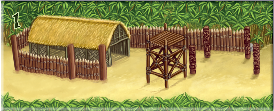
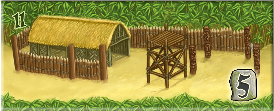
Side I: it serves only to bring this village closer to the tikis (see tikis).
Side II: in addition, scores 5 points in the final scoring.
Exchange hut (turn of the chieftains)
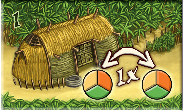
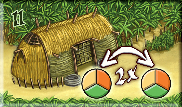
Side I: when paying, the player can exchange one commodity: feet, shells, or fruits instead of one of the others.
Side II: like side I, but he can exchange two resources. A player can use each exchange hut once per turn and cannot split its benefits.
Spear hut (turn of the chieftains)
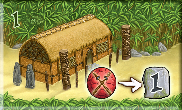
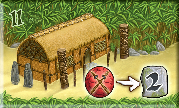
Side I: whenever a player acquires a price token with crossed spears, he immediately scores 1 point, recording it by moving his sub-chief forward 1
space on the scoring track. That is also valid for price tokens on the player sequence track.
Side II: like Side I, but he scores 2 points. Players cannot use spear and exchange huts in the turn they are bought. Their effects are additive.
Irrigation system (final scoring and end of the round)
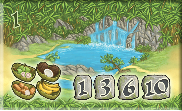
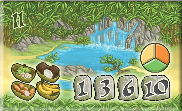
Side I: the side I counts only for the final scoring. The player scores 1-10 points for 1-4 fruit tiles in the same village.
Side II: in addition, the player receives 1 extra shell, 1 extra foot or 1 extra fruit from the supply manager at the
end of each round (the player chooses).
Surfer (round end)


Side I: at the end of each round, the surfer reduces the large number on the round indicator for this player by 2.
Side II: like Side I, but the reduction is by 4. Surfer effects are also additive.
Hula dancer (final scoring)


Side I: during the final scoring, the hula dancer scores 1 point for each place tile in the village she is in (and only there!). She
includes herself and the start hut. Side II: like Side I, but 2 points each.
Tiki (final scoring)

The tikis are important for the final scoring. The player only scores villages which extend
to the row of tikis. That is, there must be at least 1 tiki above one place tile of the village.
To make this clear when scoring villages, the players remove all place tiles of villages that do not reach at
least 1 tiki before scoring the villages.
Kahuna (final scoring)

The kahunas (expert) score the points shown during the final scoring (naturally only if the village is scored, see tikis).
Special feature with the tikis and kahunas: when the player puts a tiki on a space, which shows 1 or more
feet, he receives these immediately from the supply manager.
The same is true for kahunas, except there are shells instead of feet. The player must first pay for the
kahuna; he cannot use these shells to help with the payment. Kahunas can be placed in front of villages not yet started.
Note:
In the Yucata implementation there is the following restriction when taking Tikis or Kahunas:
Kahunas: If all 5 Kahuna fields on the player tableau are filled the player may not take any further Kahuna tile. If the player has only 1 empty Kahuna field left he may still take the island with 2 Kahunas.
Tikis: If all 7 Tiki fields on the player tableau are filled the player may not take any further Tiki tile. If the player has only 1 empty Tiki field left he may still take the island with 2 Tikis.
Fishing boat (turn of the chieftains)

The fishing boat is included in the starting equipment. It has only side I and can take 2 feet.
Boat (turn of the chieftains)


Side I: this boat has room for 3 feet. Side II: this boat has room for 3 feet. It also has a pre-printed foot,
which counts as a foot from the player’s supply.
The player can pay up to 3 more feet or fruits and launch this boat. If the player pays
with fruits, this is not considered as mixing different currencies. To activate this boat, the player must
spend at least one fruit or foot.
Please remember: if a chieftain goes fishing, or visits an island, the player must pay with feet (not for the
move, but for fishing or the island visit). The player must have room on his available boat or
boats for the feet he pays. This can be on one or more than one boat. The player puts
the feet used back into the general supply.
The Gods (also they are place tiles):
In each village, a player may place only 1 God (to that extent they are treated like they are the same tiles).
A player may have each God only once in his entire realm.
KU (turn of the chieftains and round end)
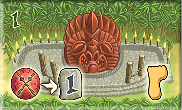
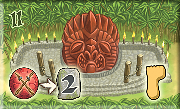
Side I: it scores 1 point for the player each time the player takes a price token with
a spear (like the spear hut). In addition, the player receives 1 extra foot at the end of
the round from the supply manager. Side II: like Side I, but with 2 points.
KANE (turn of the chieftains and round end)
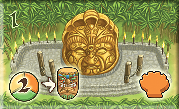
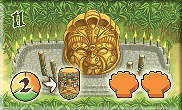
Side I: at the end of the round, the player receives 1 extra shell from the supply
manager (as with the shell hut). Side II: like Side I, but with 2 shells.
Also, for both sides: immediately after buying KANE (and only then), the player can pay any 2 resources
(also mixed) into the general supply, and take 1 tiki and put it in the appropriate place in his realm.
PELE (turn of the chieftains)
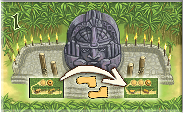
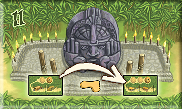
Side I: the player need pay only a maximum of 2 feet for moving his chieftain,
regardless of the distance. Of course, the player pays only 1 foot for a move of 1.
Side II: like Side I, but pays a maximum of 1 foot.
LONO (round end)
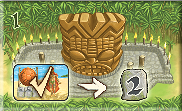
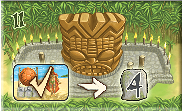
Side I: when the player’s sum equals or exceeds the large number on the round
indicator, he scores 2 extra points, regardless of his scoring position. Side II: like Side I, but +4 points.
LAKA (final scoring)
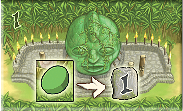
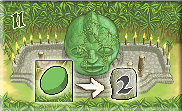
Side I: during the final scoring, the player scores 1 point for each fruit shown on all his fruit tiles. This means all fruits in the player’s realm,
not just in the village with LAKA. Side II: like Side I, but with 2 points.
KANALOA (final scoring)
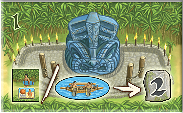
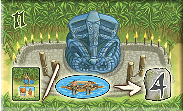
Side I: during the final scoring, the player scores 2 points for each boat and each
surfer (regardless of whether they are on side I or II). All boats and surfers in the
player’s entire realm score (only if they are still in the final scoring). Side II: like Side I, but with 4 points.
The 10 islands
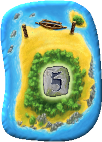
The player scores 5 points in addition to the points at the dock. This island is available twice.
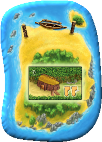
The player takes a foot hut from its place and puts it with side II in his
realm. He pays nothing for it and also takes no price token.
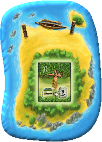
The player takes a hula dancer from her place and puts her with
side II in his realm. He pays nothing for her and also takes no price token.
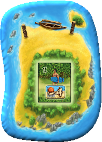
The player takes a surfer from his place and puts him with side II in
his realm. He pays nothing for it and also takes no price token.
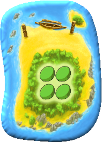
The player immediately receives 4 fruits from the supply manager.
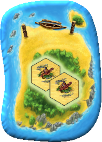
The player takes 2 kahunas from their place and puts them both on
empty spaces in his realm. He pays nothing for it and also takes no price token.
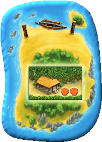
The player takes a shell hut from its place and puts it with side II in
his realm. He pays nothing for it and also takes no price token.
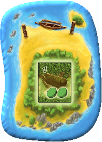
The player takes any one fruit tile from its place and puts it with side
II in his realm. He pays nothing for it and also takes no price token.
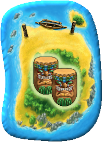
The player takes 2 tikis from the supply and puts both on empty
spaces in his realm. He pays nothing for it and also takes no price token.
When a player cannot put a place tile legally in his realm, he scores
only the points on the dock. If a player can accommodate only 1 tiki or 1 kahuna in his realm, then
he puts this one and leaves the other one in its place.
When a place has nothing left, the player cannot take anything.